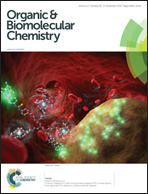Effects of (5′S)-5′,8-cyclo-2′-deoxyadenosine on the base excision repair of oxidatively generated clustered DNA damage. A biochemical and theoretical study†
Abstract
The presence of 5′,8-cyclo-2′-deoxyadenosine (5′S)-cdA induces modifications in the geometry of the DNA duplex in the 5′-end direction of the strand and in the 3′-end direction of the complementary strand. As a consequence, the enzymes are probably not able to adjust their active sites in this rigid structure. Additionally, clustered DNA damage sites, a signature of ionising radiation, pose a severe challenge to a cell's repair machinery, particularly base excision repair (BER). To date, clusters containing a DNA base lesion, (5′S)-cdA, which is repaired by nucleotide excision repair, have not been explored. We have therefore investigated whether bistranded clusters containing (5′S)-cdA influence the repairability of an opposed AP site lesion, which is repaired by BER. Using synthetic oligonucleotides containing a bistranded cluster with (5′S)-cdA and an AP site at different interlesion separations, we have shown that in the presence of (5′S)-cdA on the 5′-end side, repair of the AP site by the BER machinery is retarded when the AP site is ≤8 bases from the (5′S)-cdA. However, if (5′S)-cdA is located on the 3′-end side with respect to the AP site, the effect on its repair is much weaker and totally disappears for distances ≥8 bases.


 Please wait while we load your content...
Please wait while we load your content...